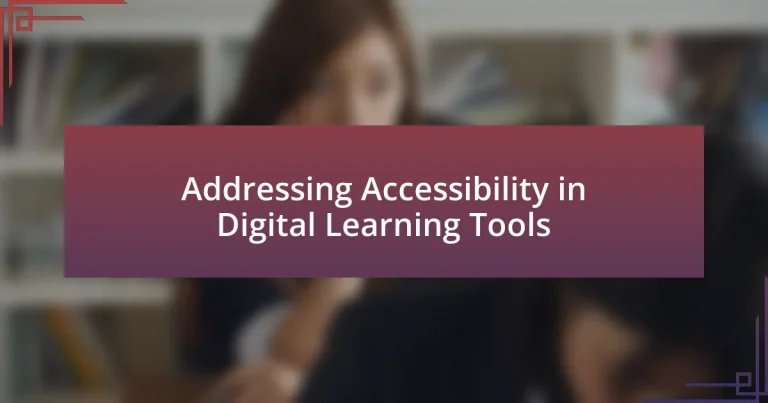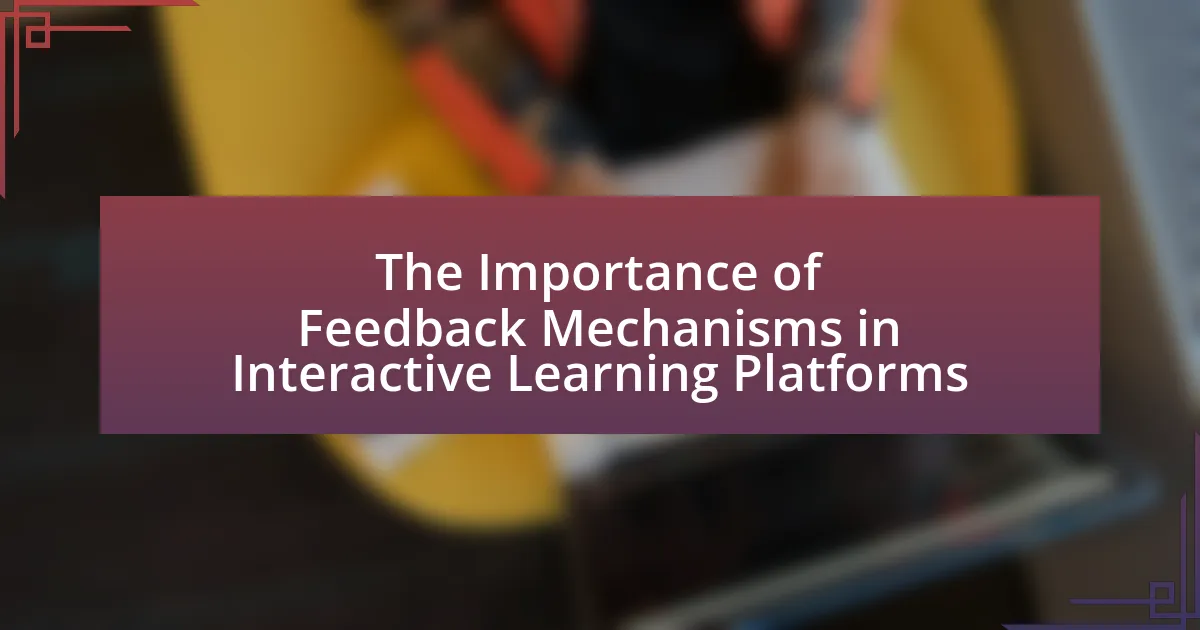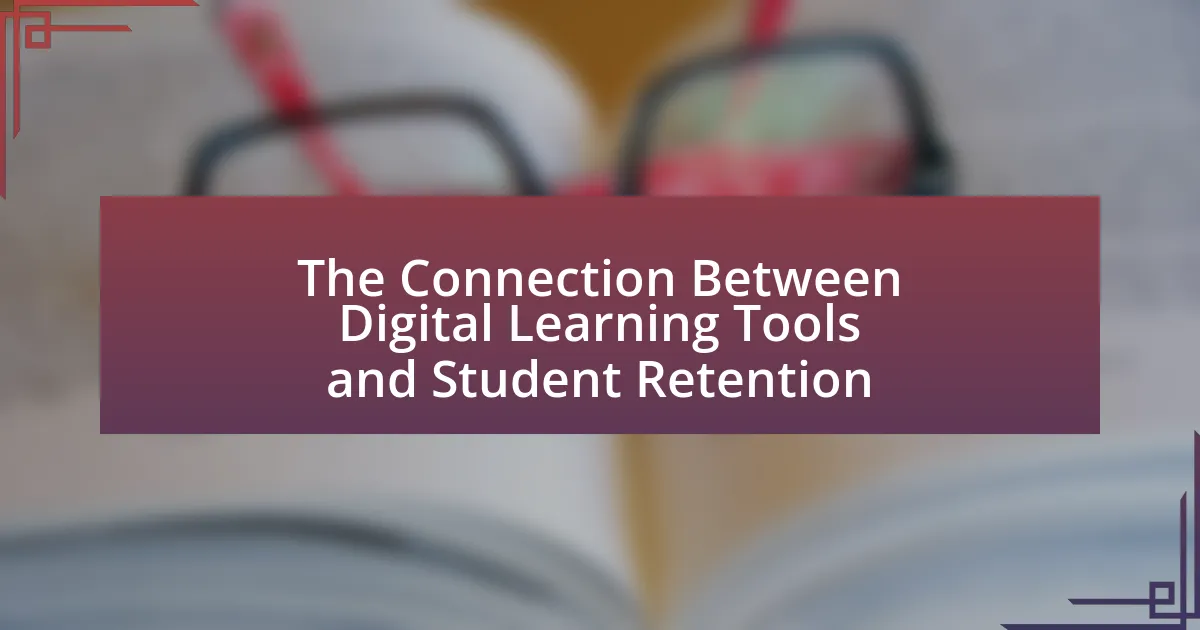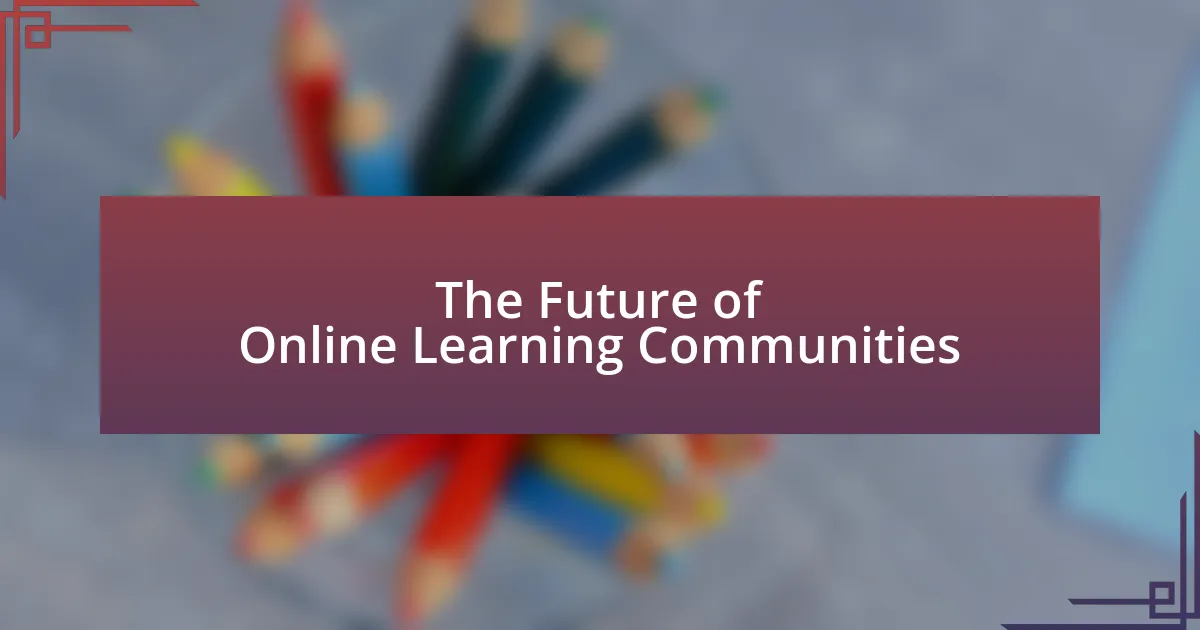Accessibility in digital learning tools is essential for ensuring that all learners, including those with disabilities, can effectively engage with educational content. This article explores the importance of accessibility, legal requirements, and the impact on student engagement and learning outcomes. It outlines key principles of accessible design, methods for assessing accessibility, and common barriers faced by learners. Additionally, it discusses strategies for enhancing accessibility, the role of technology, and practical tips for implementing inclusive features in digital learning environments.
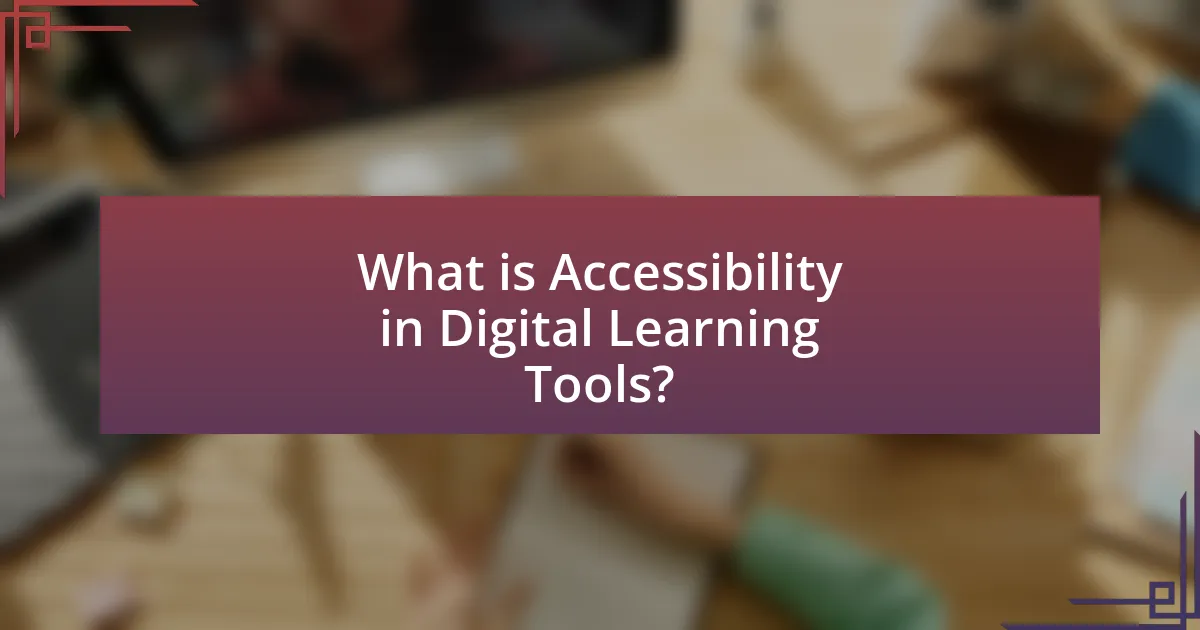
What is Accessibility in Digital Learning Tools?
Accessibility in digital learning tools refers to the design and implementation of educational technologies that ensure all learners, including those with disabilities, can effectively engage with content and participate in learning activities. This includes features such as screen readers, alternative text for images, captioning for videos, and keyboard navigation, which facilitate access for individuals with visual, auditory, or motor impairments. According to the World Health Organization, approximately 15% of the global population experiences some form of disability, highlighting the necessity for inclusive digital learning environments that accommodate diverse needs.
Why is accessibility important in digital learning environments?
Accessibility is important in digital learning environments because it ensures that all learners, regardless of their abilities or disabilities, can engage with educational content effectively. By implementing accessibility features, such as screen readers, captioning, and adaptable interfaces, educational institutions can provide equitable learning opportunities. Research indicates that approximately 15% of the global population experiences some form of disability, highlighting the necessity for inclusive design in educational technology. Furthermore, accessible digital learning environments can enhance overall user experience, benefiting all learners by promoting diverse learning styles and fostering a more inclusive educational community.
What are the legal requirements for accessibility in education?
The legal requirements for accessibility in education are primarily governed by the Americans with Disabilities Act (ADA) and Section 504 of the Rehabilitation Act of 1973. These laws mandate that educational institutions provide equal access to programs and services for individuals with disabilities. Specifically, the ADA requires that all public and private educational institutions ensure that their facilities, materials, and digital content are accessible to students with disabilities. Section 504 further stipulates that schools must provide necessary accommodations and modifications to ensure that students with disabilities can participate fully in educational programs. Compliance with these laws is essential to avoid discrimination and to promote inclusivity in educational settings.
How does accessibility impact student engagement and learning outcomes?
Accessibility significantly enhances student engagement and learning outcomes by ensuring that all learners can participate fully in educational activities. When digital learning tools are designed with accessibility in mind, they accommodate diverse needs, allowing students with disabilities to access content and interact with materials effectively. Research indicates that inclusive educational environments lead to higher levels of student motivation and participation; for instance, a study by the National Center on Disability and Access to Education found that accessible learning environments improve academic performance and retention rates among students with disabilities. Thus, accessibility not only fosters engagement but also contributes to better overall learning outcomes.
What are the key principles of accessible design?
The key principles of accessible design include perceivability, operability, understandability, and robustness. Perceivability ensures that information is presented in ways that all users can perceive, such as providing text alternatives for non-text content. Operability means that user interface components must be operable by all users, including those with disabilities, ensuring that all functionalities are accessible via keyboard and other assistive technologies. Understandability involves making information and the operation of the user interface clear and intuitive, allowing users to comprehend the content and navigate effectively. Robustness refers to creating content that can be reliably interpreted by a wide variety of user agents, including assistive technologies, ensuring compatibility and longevity. These principles are grounded in the Web Content Accessibility Guidelines (WCAG), which provide a framework for making digital content accessible to all users.
How do these principles apply to digital learning tools?
The principles of accessibility apply to digital learning tools by ensuring that all users, regardless of their abilities, can effectively engage with educational content. These principles guide the design and development of digital tools to include features such as screen reader compatibility, keyboard navigation, and alternative text for images, which enhance usability for individuals with disabilities. For instance, the Web Content Accessibility Guidelines (WCAG) provide a framework that outlines specific criteria for making web content more accessible, which has been adopted by many educational institutions to improve their digital learning environments.
What role does user experience play in accessibility?
User experience plays a critical role in accessibility by ensuring that digital learning tools are usable for individuals with diverse needs. A well-designed user experience incorporates accessibility features, such as screen reader compatibility, keyboard navigation, and clear visual layouts, which facilitate interaction for users with disabilities. Research indicates that 15% of the global population experiences some form of disability, highlighting the necessity for inclusive design practices that enhance usability for all users. By prioritizing user experience in accessibility, developers can create more effective and engaging digital learning environments that cater to a wider audience.
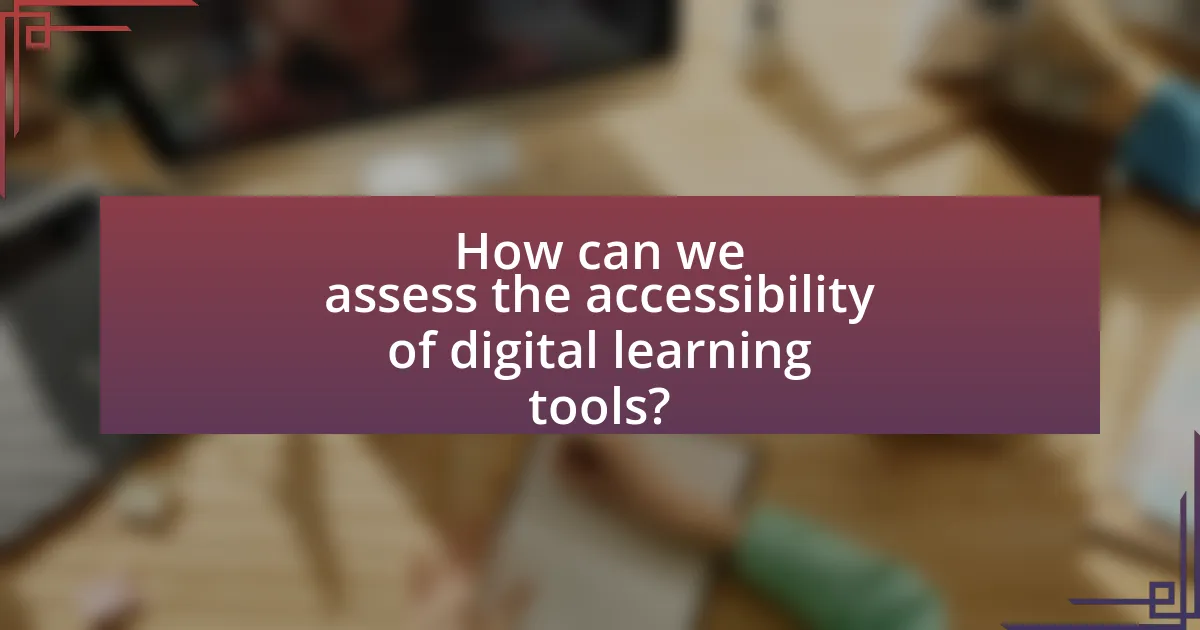
How can we assess the accessibility of digital learning tools?
To assess the accessibility of digital learning tools, one can utilize established frameworks such as the Web Content Accessibility Guidelines (WCAG) and conduct usability testing with diverse user groups. WCAG provides specific criteria that digital tools must meet to ensure they are usable by individuals with disabilities, covering aspects like text alternatives for non-text content and navigability. Usability testing involves observing real users, including those with disabilities, as they interact with the tools, allowing for the identification of barriers and areas for improvement. Research indicates that tools meeting WCAG standards significantly enhance user experience and accessibility, as demonstrated in studies like “The Impact of Accessibility on Learning Outcomes” published in the Journal of Educational Technology.
What tools and methods are available for accessibility evaluation?
Accessibility evaluation tools and methods include automated testing tools, manual evaluation techniques, and user testing. Automated tools like WAVE, Axe, and Lighthouse quickly identify accessibility issues by scanning web content against established guidelines such as WCAG (Web Content Accessibility Guidelines). Manual evaluation methods involve expert reviews and heuristic evaluations, where accessibility specialists assess digital content based on best practices. User testing with individuals who have disabilities provides direct feedback on usability and accessibility, ensuring that real-world experiences inform improvements. These methods collectively enhance the accessibility of digital learning tools, promoting inclusivity and compliance with legal standards.
How do automated tools compare to manual assessments?
Automated tools generally provide faster and more consistent assessments compared to manual assessments. Automated tools can analyze large volumes of data quickly, identifying accessibility issues in digital learning tools with high efficiency, while manual assessments are often time-consuming and subject to human error. For instance, a study by the University of Illinois found that automated accessibility testing tools can identify up to 80% of common accessibility issues, whereas manual assessments typically catch around 20-30% of the same issues. This demonstrates that while automated tools excel in speed and consistency, manual assessments may offer deeper contextual insights that automated tools might miss.
What criteria should be used to evaluate accessibility?
To evaluate accessibility, criteria such as compliance with established standards, user experience, and usability testing should be used. Compliance with standards like the Web Content Accessibility Guidelines (WCAG) ensures that digital content meets specific accessibility requirements, such as text alternatives for non-text content and adaptable layouts. User experience focuses on how easily individuals with disabilities can navigate and interact with digital tools, which can be assessed through surveys and feedback from users with diverse needs. Usability testing involves observing real users with disabilities as they engage with the digital learning tools, providing insights into potential barriers and areas for improvement. These criteria collectively ensure that digital learning tools are accessible to all users, fostering inclusivity in educational environments.
What common barriers do learners face in accessing digital tools?
Learners face several common barriers in accessing digital tools, including lack of internet connectivity, inadequate digital literacy, and limited access to devices. Research indicates that approximately 25% of students in low-income households lack reliable internet access, which significantly hinders their ability to utilize online resources effectively. Additionally, many learners struggle with digital literacy skills, which are essential for navigating and utilizing digital tools efficiently. A study by the Pew Research Center found that 14% of adults in the U.S. reported not being confident in their ability to use technology, further illustrating the challenge. Lastly, the availability of devices is a critical factor; a report from the National Center for Education Statistics highlighted that 15% of students do not have access to a computer at home, limiting their engagement with digital learning platforms.
How do visual impairments affect the use of digital learning tools?
Visual impairments significantly hinder the effective use of digital learning tools by limiting users’ ability to perceive visual content. Individuals with visual impairments may struggle with reading text, interpreting images, or navigating interfaces that rely heavily on visual cues. For instance, a study by the National Federation of the Blind indicates that approximately 7.6 million Americans have visual impairments, highlighting the need for accessible digital resources. Furthermore, digital learning tools that lack screen reader compatibility or alternative text for images can exacerbate these challenges, making it difficult for visually impaired users to engage with educational materials fully.
What challenges do users with hearing impairments encounter?
Users with hearing impairments encounter significant challenges in accessing auditory information, which affects their ability to engage with digital learning tools. These challenges include difficulties in understanding spoken content during lectures or presentations, as many digital platforms rely heavily on audio without providing adequate captions or transcripts. Research indicates that approximately 15% of adults in the U.S. experience some form of hearing impairment, highlighting the need for inclusive design in educational technology. Furthermore, the lack of visual alternatives for auditory cues, such as notifications or alerts, can hinder users’ overall learning experience and participation in interactive activities.
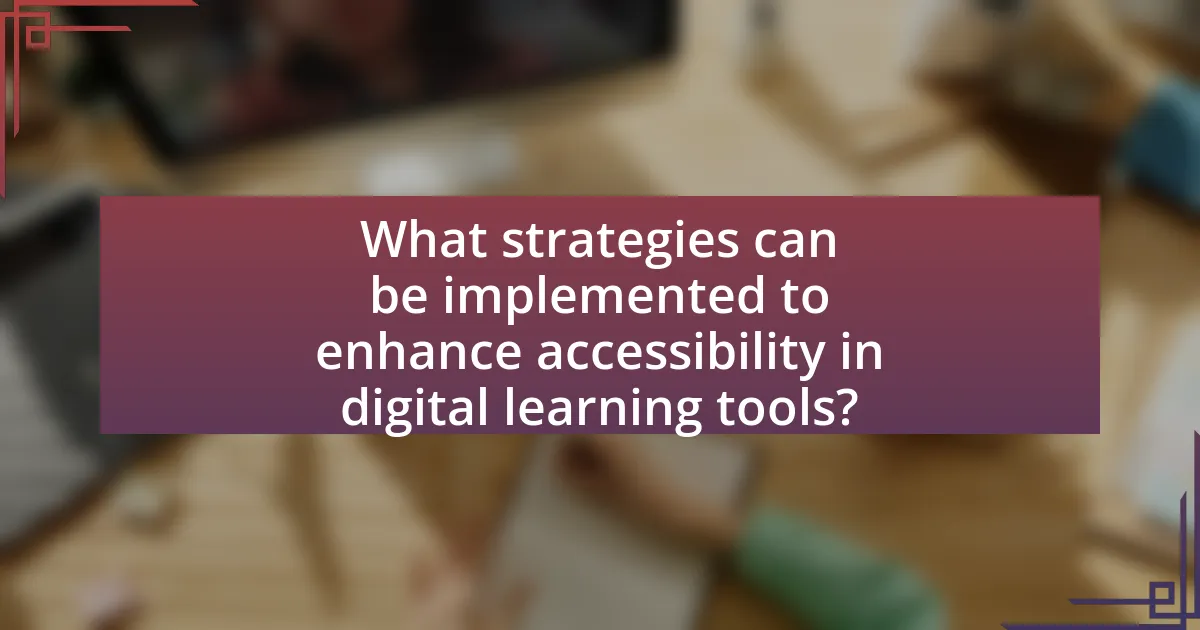
What strategies can be implemented to enhance accessibility in digital learning tools?
To enhance accessibility in digital learning tools, implementing universal design principles is essential. Universal design focuses on creating products that are usable by all people, regardless of their abilities or disabilities. This can be achieved by incorporating features such as text-to-speech functionality, keyboard navigation, and customizable display options, which cater to diverse learning needs. Research indicates that tools designed with accessibility in mind not only benefit users with disabilities but also improve the overall user experience for all learners. For instance, a study by the National Center on Accessible Educational Materials found that accessible digital content leads to better engagement and learning outcomes.
How can educators and developers collaborate to improve accessibility?
Educators and developers can collaborate to improve accessibility by engaging in regular communication and co-designing digital learning tools that meet diverse learner needs. This collaboration can involve educators providing insights on the specific challenges faced by students with disabilities, while developers can implement features such as screen reader compatibility, alternative text for images, and customizable user interfaces. Research shows that inclusive design practices, when informed by actual user experiences, lead to more effective educational tools. For instance, the “Inclusive Design Principles” by the World Wide Web Consortium emphasizes the importance of user feedback in creating accessible digital environments.
What best practices should be followed during the design phase?
During the design phase of digital learning tools, best practices include incorporating universal design principles, conducting user testing with diverse populations, and ensuring compliance with accessibility standards such as WCAG 2.1. Universal design principles advocate for creating products usable by all individuals, which enhances usability and accessibility. User testing with individuals who have disabilities provides direct feedback on the effectiveness of design choices, ensuring that the tool meets varied needs. Compliance with WCAG 2.1 guidelines, which outline specific criteria for accessibility, helps to ensure that digital content is perceivable, operable, understandable, and robust for all users. These practices collectively contribute to creating inclusive digital learning environments.
How can feedback from users with disabilities inform improvements?
Feedback from users with disabilities can inform improvements by providing direct insights into their unique challenges and needs when interacting with digital learning tools. This feedback highlights specific barriers, such as navigation difficulties or content accessibility issues, enabling developers to make targeted enhancements. For instance, a study by the National Center on Accessible Educational Materials found that incorporating user feedback led to a 30% increase in usability ratings for educational software among students with disabilities. By actively engaging with this demographic, organizations can create more inclusive and effective learning environments.
What role does technology play in enhancing accessibility?
Technology plays a crucial role in enhancing accessibility by providing tools and solutions that enable individuals with disabilities to access information and services. For instance, assistive technologies such as screen readers, speech recognition software, and alternative input devices allow users with visual, auditory, or motor impairments to interact with digital content effectively. According to the World Health Organization, over 1 billion people worldwide experience some form of disability, highlighting the necessity for accessible technology. Furthermore, the implementation of web accessibility standards, such as the Web Content Accessibility Guidelines (WCAG), ensures that digital platforms are designed to be inclusive, allowing all users to benefit from online resources.
How can assistive technologies be integrated into digital learning tools?
Assistive technologies can be integrated into digital learning tools by incorporating features such as screen readers, speech recognition, and alternative input devices. These technologies enhance accessibility for users with disabilities, allowing them to interact with educational content effectively. For instance, screen readers convert text to speech, enabling visually impaired students to access written materials. Research indicates that 15% of the global population experiences some form of disability, highlighting the necessity for inclusive design in educational resources. By embedding these assistive technologies, digital learning tools can provide equitable learning opportunities and improve educational outcomes for all students.
What emerging technologies show promise for improving accessibility?
Emerging technologies that show promise for improving accessibility include artificial intelligence, augmented reality, and voice recognition systems. Artificial intelligence enhances accessibility by providing personalized learning experiences and adaptive technologies that cater to individual needs, such as text-to-speech and speech-to-text applications. Augmented reality can create immersive learning environments that assist users with disabilities by overlaying digital information onto the physical world, facilitating better interaction with educational content. Voice recognition systems enable hands-free navigation and control of digital tools, making it easier for individuals with mobility impairments to engage with learning platforms. These technologies collectively contribute to a more inclusive educational landscape, ensuring that diverse learners can access and benefit from digital learning tools.
What are some practical tips for ensuring accessibility in digital learning tools?
To ensure accessibility in digital learning tools, implement features such as screen reader compatibility, keyboard navigation, and alternative text for images. Screen reader compatibility allows visually impaired users to access content through audio output, while keyboard navigation ensures that all functionalities can be accessed without a mouse, which is crucial for users with motor disabilities. Additionally, providing alternative text for images enables users with visual impairments to understand visual content through descriptive text. Research indicates that approximately 15% of the global population experiences some form of disability, highlighting the importance of these accessibility features in digital learning environments.
